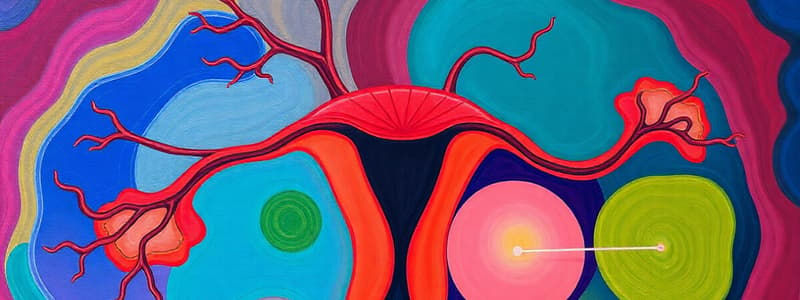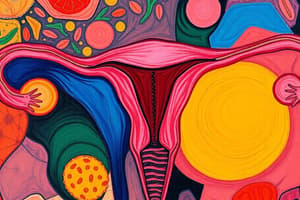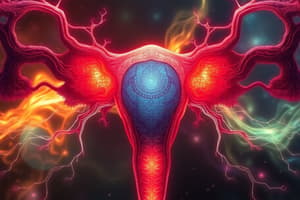Podcast
Questions and Answers
What does CRL stand for in the context of embryonic measurements?
What does CRL stand for in the context of embryonic measurements?
- Crown Radii Length
- Crown Head Length
- Crown Heel Length
- Crown Rump Length (correct)
What are the primary germ layers in embryonic development?
What are the primary germ layers in embryonic development?
- Neuroectoderm, endoderm, and ectoderm
- Somites, dermatomes, and myotomes
- Ectoderm, mesoderm, and endoderm (correct)
- Epidermis, mesoderm, and neural crest
What developmental stage is referred to as a fetus?
What developmental stage is referred to as a fetus?
- From the ninth week of pregnancy until birth (correct)
- From the first week to the eighth week of pregnancy
- From the moment of conception until birth
- From the fourth week until the tenth week of pregnancy
Which structures are derived from the parasympathetic mesoderm?
Which structures are derived from the parasympathetic mesoderm?
What condition does having only one umbilical artery potentially indicate?
What condition does having only one umbilical artery potentially indicate?
What is the most likely explanation for bleeding in the last trimester of pregnancy?
What is the most likely explanation for bleeding in the last trimester of pregnancy?
How many pairs of somites are present by the end of the fifth week of development?
How many pairs of somites are present by the end of the fifth week of development?
Which component provides the epidermis of the skin?
Which component provides the epidermis of the skin?
Where is the most common site of ectopic pregnancy implantation?
Where is the most common site of ectopic pregnancy implantation?
What is the role of the intraembryonic celom?
What is the role of the intraembryonic celom?
What characterizes the fetal side of the placenta?
What characterizes the fetal side of the placenta?
What does the lateral plate mesoderm differentiate into?
What does the lateral plate mesoderm differentiate into?
What are the primary sex organs responsible for producing gametes in males and females?
What are the primary sex organs responsible for producing gametes in males and females?
Which of the following correctly describes the female gamete?
Which of the following correctly describes the female gamete?
What is the average weight of a full-term placenta?
What is the average weight of a full-term placenta?
What is the significance of fertilization in terms of chromosomal composition?
What is the significance of fertilization in terms of chromosomal composition?
During which phase of the menstrual cycle does the endometrium thicken in preparation for potential implantation?
During which phase of the menstrual cycle does the endometrium thicken in preparation for potential implantation?
What happens during the cleavage stage of embryonic development?
What happens during the cleavage stage of embryonic development?
Where does fertilization typically occur in the female reproductive system?
Where does fertilization typically occur in the female reproductive system?
Which layer forms the inner lining of the uterus?
Which layer forms the inner lining of the uterus?
What chromosomal composition does a typical gamete contain?
What chromosomal composition does a typical gamete contain?
What is the significance of the primitive streak in embryonic development?
What is the significance of the primitive streak in embryonic development?
Which statement correctly describes the notochord?
Which statement correctly describes the notochord?
What structure replaces the notochord in adult humans?
What structure replaces the notochord in adult humans?
What marks the changes of the embryonic disc into a cylindrical structure?
What marks the changes of the embryonic disc into a cylindrical structure?
Which germ layer is formed by the displacement of the hypoblast by epiblast cells?
Which germ layer is formed by the displacement of the hypoblast by epiblast cells?
What is the role of chorionic villi at the end of the third week?
What is the role of chorionic villi at the end of the third week?
During the folding of the embryo, which aspect of development is notably modified?
During the folding of the embryo, which aspect of development is notably modified?
How does the embryonic disc change shape during the third week?
How does the embryonic disc change shape during the third week?
What forms from the outer cells of the morula during the first week of pregnancy?
What forms from the outer cells of the morula during the first week of pregnancy?
Where is the common site of implantation in the uterus?
Where is the common site of implantation in the uterus?
What is the name of the process where a cavity develops inside the morula during the second week?
What is the name of the process where a cavity develops inside the morula during the second week?
What do the cells of the wall of the umbilical vesicle produce?
What do the cells of the wall of the umbilical vesicle produce?
What fills the defect left by the embedded blastocyst in the endometrium by the 10th day?
What fills the defect left by the embedded blastocyst in the endometrium by the 10th day?
What are the two layers formed from the embryoblast during the early stages of the second week?
What are the two layers formed from the embryoblast during the early stages of the second week?
Which layer of the trophoblast develops into the syncytiotrophoblast during the second week?
Which layer of the trophoblast develops into the syncytiotrophoblast during the second week?
What signifies the beginning of gastrulation in the development process?
What signifies the beginning of gastrulation in the development process?
What is the primary function of the placenta related to metabolism?
What is the primary function of the placenta related to metabolism?
What condition results from abnormal implantation of the placenta inside the endometrium?
What condition results from abnormal implantation of the placenta inside the endometrium?
What significant change occurs to the placental membrane in the last trimester of pregnancy?
What significant change occurs to the placental membrane in the last trimester of pregnancy?
What is hydramnios characterized by?
What is hydramnios characterized by?
What structure is responsible for maintaining homeostasis of fluid and electrolytes around the embryo?
What structure is responsible for maintaining homeostasis of fluid and electrolytes around the embryo?
Which type of twins originate from two separate zygotes?
Which type of twins originate from two separate zygotes?
At full term, what is the approximate length of the umbilical cord?
At full term, what is the approximate length of the umbilical cord?
What is the expected date of delivery of a fetus calculated from fertilization?
What is the expected date of delivery of a fetus calculated from fertilization?
Flashcards
Fertilization
Fertilization
The process by which male and female gametes (sperm and egg) fuse to form a zygote, restoring the diploid number of chromosomes.
Cleavage (Segmentation)
Cleavage (Segmentation)
The repeated cell division of the zygote, resulting in blastomeres, which are embryonic cells that increase the number of cells without increasing the overall size of the embryo.
Ovarian Cycle
Ovarian Cycle
The cyclic changes occurring in the ovary every lunar month; it includes three stages - follicular, ovulation, and luteal.
Menstrual Cycle
Menstrual Cycle
Signup and view all the flashcards
Primary Sex Organs (Gonads)
Primary Sex Organs (Gonads)
Signup and view all the flashcards
Gametogenesis
Gametogenesis
Signup and view all the flashcards
Secondary Oocyte
Secondary Oocyte
Signup and view all the flashcards
Sperm
Sperm
Signup and view all the flashcards
Morula
Morula
Signup and view all the flashcards
Trophoblast
Trophoblast
Signup and view all the flashcards
Blastocyst
Blastocyst
Signup and view all the flashcards
Primitive streak
Primitive streak
Signup and view all the flashcards
Implantation
Implantation
Signup and view all the flashcards
Primitive node
Primitive node
Signup and view all the flashcards
Decidua
Decidua
Signup and view all the flashcards
Notochord
Notochord
Signup and view all the flashcards
Embryonic folding
Embryonic folding
Signup and view all the flashcards
Epiblast and Hypoblast
Epiblast and Hypoblast
Signup and view all the flashcards
Umbilical ring
Umbilical ring
Signup and view all the flashcards
Amniotic Cavity
Amniotic Cavity
Signup and view all the flashcards
Germ layer formation
Germ layer formation
Signup and view all the flashcards
Umbilical Vesicle
Umbilical Vesicle
Signup and view all the flashcards
Ectoderm
Ectoderm
Signup and view all the flashcards
Mesoderm
Mesoderm
Signup and view all the flashcards
CRL (Crown-Rump Length)
CRL (Crown-Rump Length)
Signup and view all the flashcards
CHL (Crown-Heel Length)
CHL (Crown-Heel Length)
Signup and view all the flashcards
Embryo
Embryo
Signup and view all the flashcards
Fetus
Fetus
Signup and view all the flashcards
Congenital Anomalies
Congenital Anomalies
Signup and view all the flashcards
Umbilical Cord
Umbilical Cord
Signup and view all the flashcards
Amnion
Amnion
Signup and view all the flashcards
Placental Membrane
Placental Membrane
Signup and view all the flashcards
Placenta Previa
Placenta Previa
Signup and view all the flashcards
Placenta Accreta
Placenta Accreta
Signup and view all the flashcards
Ectopic Pregnancy
Ectopic Pregnancy
Signup and view all the flashcards
Dizygotic Twins
Dizygotic Twins
Signup and view all the flashcards
Identical Twins
Identical Twins
Signup and view all the flashcards
Somite
Somite
Signup and view all the flashcards
Sclerotome
Sclerotome
Signup and view all the flashcards
Myotome
Myotome
Signup and view all the flashcards
Dermatome
Dermatome
Signup and view all the flashcards
Placenta
Placenta
Signup and view all the flashcards
Study Notes
A. Reproductive Systems
- The female reproductive system comprises two ovaries, two uterine tubes, a uterus, and a vagina.
- The uterine wall has three layers: endometrium, myometrium, and perimetrium.
- Fertilization occurs within the uterine tubes.
- The male reproductive system includes two testes, two epididymis, two seminal vesicles, two ejaculatory ducts, a prostate, and a penis.
- The primary sex organs (gonads) produce gametes: testes in males and ovaries in females.
B. Gametogenesis
- Gametes develop from germ cells that originate in the umbilical vesicle and migrate to the gonads.
- Gametogenesis transforms germ cells (46 chromosomes, diploid) into male and female gametes (23 chromosomes, haploid).
- The female gamete is a secondary oocyte (X).
- The male gamete is a sperm (X or Y).
- Gametes contain 22 autosomes and one sex chromosome.
- Errors in meiosis can lead to abnormal gametes, such as in Down syndrome.
C. Female Reproductive Cycles
- The ovarian cycle involves cyclical changes in the ovary monthly.
- The menstrual cycle involves cyclical changes in the endometrium monthly.
- The ovarian cycle phases are follicular, ovulation, and luteal.
- The menstrual cycle phases are ischemic, menstrual, proliferative, and luteal.
- Breastfeeding can temporarily cease menstruation.
D. Fertilization
- Fertilization is the fusion of male and female gametes to form a zygote.
- Fertilization typically occurs in the ampulla of the uterine tube.
- Fertilization restores the diploid chromosome number (46 chromosomes).
- Fertilization determines the embryo's sex (XX or XY).
- Embryonic age begins two weeks after the last normal menstrual period (LNMP).
E. Cleavage (Segmentation)
- Cleavage involves repeated mitotic divisions of the zygote, producing blastomeres.
- Cleavage occurs in the uterine tube during the first week of pregnancy.
- The morula is a solid ball of cells formed during cleavage.
- The morula develops into a blastocyst with an inner cell mass (embryoblast) and outer layer (trophoblast).
F. Implantation
- Implantation is the embedding of the blastocyst into the endometrium of the uterus.
- The usual implantation site is the upper posterior wall of the uterus's fundus.
- By day 10, the blastocyst is fully embedded, creating a closing plug within the endometrium.
- By the end of the second week, the endometrium is filled with edematous cells rich in glycogen and lipids (decidua).
G. Gastrulation
- Gastrulation is the beginning of morphogenesis (body form development), occurring during week 3.
- The first sign of gastrulation is the primitive streak formation, a thickened linear band of epiblast cells.
- The primitive node is at the cranial end of the primitive streak.
- The primitive streak's growth leads to the development of the notochord.
H. The 3rd Week
- The notochordal process forms a plate, which folds to form the notochord, the primordial axis of the embryo.
- The notochord is crucial for central nervous system and axial musculoskeletal development.
- The end of the 3rd week finds the embryonic disc changing shape to a flat, elongated form with a broad head and narrow tail.
- Tertiary chorionic villi form during this period.
I. Folding of the Embryo
- During the fourth week, the flat embryonic disc folds to form a cylindrical embryo.
- Folding involves the formation of a head, tail, and lateral folds, resulting in the umbilical ring.
- The chorionic villi at the embryonic pole grow and branch, forming the chorion frondosum part of the placenta.
J. Derivatives of the Germ Layers
- The epiblast forms the three germ layers (ectoderm, mesoderm, endoderm).
- The ectoderm differentiates into neuroectoderm and dermoectoderm.
- The neuroectoderm gives rise to the neural tube and crest.
- The mesoderm is segmented into paraxial, intermediate, and lateral plate mesoderms.
- The paraxial mesoderm forms somites, crucial for skeletal, muscular and connective tissue development.
- The number of somites can be used to determine the embryo's age.
- The intermediate mesoderm contributes to the urogenital system.
- The lateral plate mesoderm forms the intraembryonic coelom and subsequently the pericardial, pleural and peritoneal cavities.
K. Placenta
- The placenta is the fetal-maternal organ responsible for gas and nutrient exchange.
- The full-term placenta is discoid, weighing approximately 500g and expelled within 30 minutes of birth.
- The fetal side of the placenta, derived from the chorion frondosum, is smooth and covered by the amnion.
- The maternal side, derived from the decidua basalis, is irregular and divided into cotyledons.
L. Umbilical Cord
- The umbilical cord is about 50 cm long at full term.
- The cord contains two arteries and one vein, enveloped in Wharton's jelly.
M. Twins
- Dizygotic twins arise from two separate zygotes.
- Monozygotic twins arise from one zygote.
- Conjoined twins result from incomplete separation.
THE Amnion
- The amnion forms a fluid-filled sac that surrounds the embryo, maintaining homeostasis and supporting growth.
- Amniotic fluid volume varies but typically 800-1000ml.
- The umbilical vesicle, an older name for the yolk sac, is a pear-shaped structure connected to the midgut by a duct. It plays a role in germ cell development.
Studying That Suits You
Use AI to generate personalized quizzes and flashcards to suit your learning preferences.



